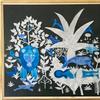'Anthropocene,' the Groundbreaking Exhibition With Thought-Provoking Imagery and AR Installations, Will Travel From Canada to Europe
- OTTAWA, Canada
- /
- February 20, 2019

Breathtaking photographs and films, immersive augmented reality experiences, cutting-edge technology: Anthropocene ends Friday in Ottawa
This groundbreaking exhibition explores human impact on the planet through large-scale photographs by Edward Burtynsky, film installations by Jennifer Baichwal and Nicholas de Pencier and, new from the artists, augmented reality installations. A 236-page exhibition book is available.
The show will travel to Fondazione MAST, in Bologna, in the spring of 2019 for its European premiere.

Anthropocene, the multimedia exhibition on view at the National Gallery of Canada until February 24, 2019, is the result of an ambitious four-year collaboration between the renowned artist Edward Burtynsky and award-winning filmmakers Jennifer Baichwal and Nicholas de Pencier. Using the most cutting-edge technology of our time, combining film, photography, augmented reality (AR) and scientific research, the exhibition offers a spectacular panorama of the enormous impact humanity has had on the planet.
“Photography is among some of the most transformative inventions – and this ambitious exhibition takes the medium to the next level with the use of immersive technology,” said Marc Mayer, Director and CEO of the National Gallery of Canada. “Through stunning photographs, films and innovative augmented reality installations – we are encouraged to explore and reflect upon the consequences of our modern way of life.”
Measuring 66 metres high, 12 metres in circumference and with a canopy spread of 18.3 metres, the artists transported a near-to-scale rendering of “Big Lonely Doug”, Canada’s second largest Douglas Fir tree, from its home in a clear-cut on Vancouver Island, British Columbia, to the Gallery’s Scotiabank Great Hall. This AR installation of the 1,000-year-old tree, triggered using a specially designed mobile app, towers over visitors as they make their way to the entrance of the exhibition.
Once inside the show, visitors come face-to-face with Sudan, the last male northern white rhinoceros who died in March 2018 at the Ol Pejeta Conservancy in Kenya, brought back to life through a detailed 3D image triggered by the same app. The app also enables visitors using their smartphone or tablet to walk around a third AR installation – a near-to-scale experience of the largest pile of elephant ivory, poached from between 6,000 and 7,000 elephants, which was set on fire at Nairobi National Park in Kenya on April 30, 2016.
“Many people now use cell phones to interact with the world”, said Andrea Kunard, Associate Curator at the Canadian Photography Institute of the National Gallery of Canada and curator of the exhibition at the Gallery. “We wanted to incorporate that aspect of lived experience in the art gallery setting. Including new lens-based technologies in the exhibition provides a richer experience for the visitor.”
Visitors to the show will also be able to access an interactive film wall displaying nine short and stunning clips by Baichwal and de Pencier depicting diverse subjects such as the huge landfill site in Nairobi, Kenya, a seemingly endless procession of coal trains in Wyoming, and coral bleaching in Australia’s Great Barrier Reef. Film extensions by Baichwal and de Pencier are also triggered through the mobile app to complement wall-sized, high-resolution murals photographed by Edward Burtynsky.
The exhibition is part of a larger project which includes the documentary film, ANTHROPOCENE: The Human Epoch, which had its world premiere at TIFF ’18 and had its Ottawa premiere at the National Gallery of Canada on September 27, 2018, and an art book published by Steidl, on sale at the Gallery Boutique. Anthropocene is based on the research of the Anthropocene Working Group, an international organization of scientists working to determine whether the Earth has left the Holocene and entered a new geological epoch ― the Anthropocene. The exhibition is complemented by an educational program organized by the Gallery that explores the issues raised in the photographs, films and augmented reality installations, and includes an interactive area where visitors can learn more about The Anthropocene Project, and share their comments on a social media wall about what they have seen and experienced.
As Burtynsky himself noted, “The work asks more questions than it answers; which is what artists are there to do.”
To fully experience the exhibition, visitors to the National Gallery of Canada are encouraged to download the free AVARA app, available on Google Play and the Apple App Store in advance of their visit. The app can then be used to activate each of the augmented reality installations, interactive experiences and film extensions within the high-resolution murals. iPads with the app pre-installed will also be available within the exhibition space.
Anthropocene is organized by the Canadian Photography Institute of the National Gallery of Canada and the Art Gallery of Ontario (AGO), and co-produced with the Fondazione MAST, Bologna, Italy. A complementary exhibition ran at the AGO in Toronto from September 28, 2018 to January 6, 2019. The exhibitions each offer a rich and distinct experience, with key works on display at both venues.













_small100x100_c.jpg)

